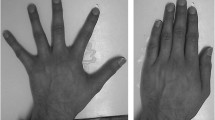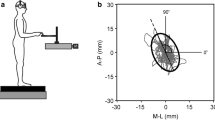Abstract
Touch and pressure stimulation of the body surface can strongly influence apparent body orientation, as well as the maintenance of upright posture during quiet stance. In the present study, we investigated the relationship between postural sway and contact forces at the fingertip while subjects touched a rigid metal bar. Subjects were tested in the tandem Romberg stance with eyes open or closed under three conditions of fingertip contact: no contact, touch contact (<0.98 N of force), and force contact (as much force as desired). Touch contact was as effective as force contact or sight of the surroundings in reducing postural sway when compared to the no contact, eyes closed condition. Body sway and fingertip forces were essentially in phase with force contact, suggesting that fingertip contact forces are physically counteracting body sway. Time delays between body sway and fingertip forces were much larger with light touch contact, suggesting that the fingertip is providing information that allows anticipatory innervation of musculature to reduce body sway. The results are related to observations on precision grip as well as the somatosensory, proprioceptive, and motor mechanisms involved in the reduction of body sway.
Similar content being viewed by others
References
Benson AJ (1982) The vestibular sensory system. In: Barlow HB, Mollon JD (eds) The senses. Cambridge University Press, Cambridge, UK, pp 333–368
Brandt T, Büchele W, Arnold F (1977) Arthrokinetic nystagmus and ego-motion sensation. Exp Brain Res 30:331–338
Burgess PR, Wei JY, Clark FJ, Simon J (1982) Signaling of kinesthetic information by peripheral sensory receptors. Ann Rev Neurosci 5:171–187
Correia MJ, Guedry FE (1966) Modification of vestibular responses as a function of rate of rotation about an Earth-horizontal axis. Acta Otolaryngol 62:297–308
Dichgans J, Brandt T (1973) Visual-vestibular interaction. Effects on self-motion perception and postural control. In: Held R, Leibowitz HW, Teuber HL (eds) Handbook of sensory physiology. Springer, Berlin Heidelberg New York 755–804
Diener HC, Dichgans J, Guschlbauer B, Mau H (1984) The significance of proprioception on postural stabilization as assessed by ischemia. Brain Res 296:103–109
Gordon G (1978) Active touch. The mechanism of recognition of objects by manipulation: a multi-disciplinary approach. Pergamon, Oxford
Gurfinkel VS, Levik YS (1994)The suppression of cervico-ocular response by the haptokinetic information about the contact with a rigid, immobile object. Exp Brain Res
Holden M, Ventura J, Lackner JR (1987) In fluence of light touch from the hand on postural sway. Soc Neurosci Abstr 13 (1):348
Holden M, Ventura J, Lackner JR (1994) Stabilization of posture by precision contact of the index finger. J Vest Res 4:285–301
Howard IP (1986) The perception of posture, self motion and the visual vertical. In: Boff KR, Kaufmann L, Thomas JP (eds) Sensory processes and perception. (Handbook of perception and human performance, vol 1). Wiley, New York, pp 18–1–18–62
Hullinger M, Nordh E, Thelin A-E, Vallbo ÅB (1979) The responses of afferent fibres from the gabrous skin of the hand during voluntary finger movements in man. J Physiol (Lond) 291:233–249
Johansson RS (1991) How is grasping modified by somatosensory input? In: Humphrey DR, Freund H-J (eds) Motor control: concepts and issues. Wiley, New York, pp 331–355
Johnson KO, Hsiao SS (1992) Neural mechanisms of tactual form and texture perception. Ann Rev Neurosci 15:227–250
Katz D (1950) Gestalt psychology: its nature and significance. Ronald, New York
Kelso JAS, Tuller B (1983) ‘Compensatory articulation’ under conditions of reduced afferent information: a dynamic formation. J Speech Hear Res 26:218–223
Kirk RE (1982) Experimental design: procedures for the behavioral sciences. Brooks/Cole, Belmont, Calif
Knibestöl M (1975) Stimulus-response functions of slowly adapting mechanoreceptors in the human glabrous skin area. J Physiol (Lond) 345:63–80
Lackner JR (1981) Some contributions of touch, pressure and kinesthesis to human spatial orientation and oculomotor control Acta Astronautica 8(8):825–830
Lackner JR (1992) Multimodal and motor influences on orientation: implications for adapting to weightless and virtual environments. J Vest Res 2:307–322
Lackner JR, Graybiel A (1978a) Some influences of touch and pressure cues on human spatial orientation. Aviat Space Environ Med 49:798–804
Lackner JR, Graybiel A (1978b) Postural illusions experienced during z-axis recumbent rotation and their dependence on somatosensory stimulation of the body surface. Aviat Space Environ Med 49:484–488
Lackner JR, DiZio P (1984) Some efferent and somatosensory influences on body orientation and oculomotor control. In: Wooten R, Spillman L (eds) Sensory experience, adaptation and perception. Erlbaum, Hillsdale, NJ, pp 281–301
Marsden CD, Merton PA, Morton HB (1981) Human postural responses. Brain 104:513–534
Matthews PBC (1981) Evolving views on the internal operation and functional role of the muscle spindle. J Physiol (Lond) 320:1–30
Matthews PBC (1988) Proprioceptors and their contribution to somatosensory mapping: complex messages require complex processing. Can J Physiol Pharmacol 66:430–438
Mauritz KH, Dichgans J, Hufschmidt A (1979) Quantitative analysis of stance in late cortical cerebellar atrophy of the anterior lobe and other forms of cerebellar ataxia. Brain 102:461–482
Nashner LM (1976) Adapting reflexes controlling the human posture. Exp Brain Res 26:59–72
Nashner LM (1981) Analysis of stance posture in humans. In: Towe A, Luschei E (eds) Motor coordination. (Handbook of behavioural neurobiology, vol 5) Plenum Press, New York, pp27–565
Nashner LM (1982) Adaptation of human movement to altered environments. Trends Neurosci 5:358–361
Phillips CG (1985) Movements of the hand. Liverpool University, Liverpool
Senders V (1958) Measurement and statistics. Oxford University Press, New York
Srinivasan MA, Whitehouse JM, LaMotte RH (1990) Tactile detection of slip: surface microgeometry and peripheral neural codes. J Neurophysiol 63(6):1323–1332
Westling G, Johansson RS (1987) Responses in glabrous skin mechanoreceptors during precision grip in humans. Exp Brain Res 66:128–140
Winter DA, Patla AE, Frank JS (1990) Assessment of balance control in humans. Med Prog Technol 16:31–51
Author information
Authors and Affiliations
Rights and permissions
About this article
Cite this article
Jeka, J.J., Lackner, J.R. Fingertip contact influences human postural control. Exp Brain Res 79, 495–502 (1994). https://doi.org/10.1007/BF00229188
Received:
Accepted:
Issue Date:
DOI: https://doi.org/10.1007/BF00229188




